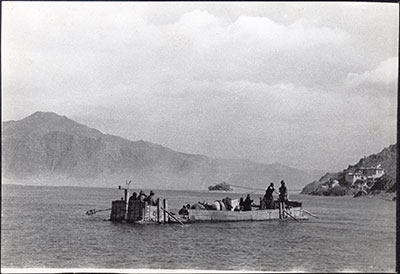
1998.131.180 (Print black & white)


1998.131.180 (Print black & white)

Frederick Spencer Chapman
Frederick Spencer Chapman
December 14th 1936?
Tsangpo Valley Region > Chaksam
1998.131.180
116 x 169 mm
Print gelatin silver , Retouched
Donated 1994
Faith Spencer Chapman
Crop marks
British Diplomatic Mission to Lhasa 1936-37
Frederick Spencer Chapman
Chapman or Nepean?
BD.6 In publication
'Lhasa Mission 1936, Diary of Events', P. Neame, H. Richardson, F. S. Chapman, Government of India Political Department [Note: photographs for October 18th - November 4th 1936 are not included as their relationship to text is not detailed; see Mission Diary text for details of images] [see photos in publication]
SC.T.2.180
BMR.86.1.70.4 2001.35.301.1
'Lhasa Mission 1936, Diary of Events', P. Neame, H. Richardson, F. S. Chapman, Government of India Political Department [Note: photographs for October 18th - November 4th 1936 are not included as their relationship to text is not detailed; see Mission Diary text for details of images] [view list of illustrations]
Notes on print/mount - The back of the print is covered in annotations and crop marks. The instruction 'Bring out suspension bridge' is written in pencil on the back across the bottom. This probably refers to the fact that the line denoting the bridge has been drawn on by hand. Other annotations on the back of the print, including '4b' in the top left hand corner. It is indicated that a crop should be made on the left hand side of the image (26mm). This would de-centre the ferry in the image, but would reduce the extent of presence of water and mountains on the left hand side of the frame. The reference number 'B-D-6' has been written in the centre of the print on the back. This relates to the numbering system adopted for photographs taken during the Mission to Lhasa in 1936 [MS 14/01/2005]
Manual Catalogues - Caption in Chapman's hand-written list of negatives made whilst on the Mission to Lhasa, 1936-7 [See PRM Manuscripts Collection]: '[Chaksam] Ferry in centre of picture'; PRM Manuscripts Collection: ‘List of Tibetan Prints and Negatives’ - Book 1, From Gangtok to the Natu La August 1936: ‘26/3 - Chaksam ferry and monastery in background. Notice horse’s head on ferry and sandstorm in distance’ [MS 12/03/2006]
Other Information - Related Images: Images prefixed with 'BD' seem to have been taken during Chapman's December 1936 trip to Yamdrok lake. They comprise a group of negatives containing images of Jangme village, Chaksam and ferry, Nepean and Sona Mundhu, Nakartse, animals and birds, Karo La, yaks descending pass. Chapman escorted Nepean, who was returning to India, to Nakartse, and then remained near Yamdrok Tso to take photographs of the flora and fauna and await the arrival of Major Finch who was to visit Lhasa over the Christmas period [MS 12/03/2006]
Other Information - Setting: The image just above the water level in the distance appears to be clouded (possibly a dust storm, haze etc.). It may be because of this that the line highlighting the location of the bridge has been drawn onto the print by hand. In the Mission Diary for December 23rd 1936, to which this image is attached as an illustration, Chapman makes the following comment: "Returning to Lhasa from this lake [Yamdrok Tso] the Kampa La (15,400) was crossed; though in summer, when the Tsang Po was flooded that the ferry could not be used, we were forced to cross by the higher Nyapso La. A rough track was followed downwards for 4,000 feet to the valley of the Tsang Po, which was crossed at Chaksam Ferry. Anyone using the ferry would be well advised to cross very early morning, as on each occasion that we were there the whole valley was swept by so violent a dust storm that we had to wait for several hours before it was safe for the crazy old box of a boat to venture out into mid-stream". The need to highlight the bridge in the background seems also to have been influenced by the presence of a dust storm on the far banks of the river [MS 13/01/2005]
Other Information - Historical Background: Tangton Gyalpo was renowned for his bridge building and was responsible for building over 100 Bridges, as well as for his development of Tibetan music and drama. Chaksam is Tibetan for iron bridge. [Zara Fleming 1995.1?]
For Citation use:
The Tibet Album.
"Chaksam ferry and Chushul Monastery"
05 Dec. 2006. The Pitt Rivers Museum.
<http://tibet.prm.ox.ac.uk/photo_1998.131.180.html>.
For more information about photographic usage or to order prints, please visit the The Pitt Rivers Museum.
© The Pitt Rivers Museum